
About UsThe Numismatic Bibliomania Society is a non-profit organization promoting numismatic literature. For more information please see our web site at coinbooks.org SubscriptionsThose wishing to become new E-Sylum subscribers (or wishing to Unsubscribe) can go to the following web page link MembershipThere is a membership application available on the web site Membership Application To join, print the application and return it with your check to the address printed on the application. Membership is only $15 to addresses in the U.S., $20 for First Class mail, and $25 elsewhere. For those without web access, write to: David M. Sundman, Secretary/TreasurerNumismatic Bibliomania
Society AsylumFor Asylum mailing address changes and other membership questions, contact David at this email address: dsundman@LittletonCoin.com SubmissionsTo submit items for publication in The E-Sylum, just Reply to this message, or write to the Editor at this address: whomren@coinlibrary.com
BUY THE BOOK BEFORE THE COINYou won't regret it! |
- WAYNE'S WORDS: THE E-SYLUM MAY 27, 2012
- NEW BOOK: HISTORY OF OTTOMAN COINS, VOLUME 5
- NEW BOOK: QUEBEC'S NUMISMATIC CATALOGUE
- NEW BOOK: WWII PAPER MONEY AND FINANCIAL INSTRUMENTS OF NAZI GERMANY
- BOOK REVIEW: A CONCISE CATALOG OF U.S. MILITARY PAYMENT CERTIFICATES
- BOOK REVIEW: TEN DAYS TO MADNESS
- REGIONAL PUBLICATIONS OFTEN REVEAL TREASURES
- VINCENT W. ALONES, 1916 - 2012
- QUERY: COUNTERFEIT PRINCE EDWARD ISLAND HOLEY DOLLARS
- QUERY: JOHNS ADAMS' GOLD 1826 ERIE CANAL COMPLETION MEDAL
- MORE ON THE 1870-S THREE DOLLAR GOLD PIECE
- ANSWER: WHAT DOES N.I.T. ON BRYAN MONEY STAND FOR?
- WHO IS THAT GENT WITH LINCOLN AND GRANT? ALEXANDER II
- NOTES FROM E-SYLUM READERS: MAY 27, 2012
- ANA APPOINTS AUTHOR JEFF SHEVLIN NEW EXECUTIVE DIRECTOR
- QUERY: PUZZLE BOOK PUZZLE - PROBE OR PRESERVE?
- QUERY: TO CRACK OR NOT TO CRACK?
- QUIZ ANSWER: WHICH FARMER'S BANK OF VIRGINIA NOTE IS COUNTERFEIT?
- KARL GOETZ BLACK SHAME MEDAL
- MORE ON THE FRANKLIN PARISIAN MASONIC LODGE JETON
- THE GILBERT PAPER CO $1 FEDERAL RESERVE NOTES, SERIES 1963
- THE SCRIP OF JOHN LEONARD RIDDELL
- A NUMISMATIC VISIT TO THE NEW YORK HISTORICAL SOCIETY
- THE REED AND HOLLAND PENNYPACKER AUCTION SALES
- SCOTLAND ISSUES QUEEN'S DIAMOND JUBILEE £10 NOTE
- FEATURED WEB SITE: SHEAFF : EPHEMERA
WAYNE'S WORDS: THE E-SYLUM MAY 27, 2012

New subscribers this week include Jacob Terner and Mark Busacca. Welcome aboard! We have 1,558 email subscribers, plus 177 followers on Facebook.
First, I'd like to apologize to Dave ALexander and anyone else who sent me items for The E-Sylum today - I had a computer glitch and lost many of those emails. Please resend your submissions and I'll get them into the next issue. Sorry!
To learn more about Vince Alones, POGs, the Black Shame,
beautiful women, an evil undertaker, Cherokee chiefs, an English barkeep, and a hermit/historian numismatist, read on.
Have a great week, everyone!
NEW BOOK: HISTORY OF OTTOMAN COINS, VOLUME 5
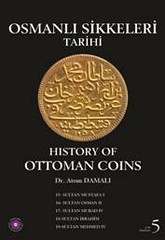 OTTOMAN SULTANS
OTTOMAN SULTANS
Mustafa I - Osman II - Murad IV - Ibrahim - Mehmed IV
From the end of the sixteenth century onwards, various administrative, military, industrial, commercial, financial and social developments that occurred within the boundaries of the Ottoman state and throughout the world were instrumental in exacerbating the economic problems of the Ottoman Empire. These developments that greatly effected the coin minting can be described briefly as follows:
- Newly discovered trade routes
- Changes in military structure and technology
- Population increase
- Rebellion in the lands of the Ottomans
- New silver mines in North America
- Capitulations to the European states
The book covers a detailed historical chronology of the Ottoman Empire, together with the brief history of the reigns of the related Sultans. The history is supported with the economic structure and problems encountered. Also a short history of the cities where the coins are minted is also presented.
Gold, silver and copper coins of the related Sultans are displayed together with the scripts on each and every coin in three languages. Photographs are enlarged for increasing the visibility of the coins and printed in full color.
For more information, see: www.niluferdamalivakfi.org/tr/index.asp?ID=1
NEW BOOK: QUEBEC'S NUMISMATIC CATALOGUE
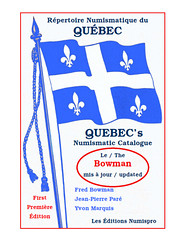 Quebec's Numismatic Catalogue is the name of a new catalogue that will be launched at NUPHILEX in Montreal on March 30. This volume is the first update of the Bowman's Tokens of Quebec catalogue published in 1972. This update, which represents many years of research, was completed by Jean-Pierre Pare and Yvon Marquis, with the contribution of Pierre Brouillette and Robert Benoit for items related to dairy and bakery in Quebec
Quebec's Numismatic Catalogue is the name of a new catalogue that will be launched at NUPHILEX in Montreal on March 30. This volume is the first update of the Bowman's Tokens of Quebec catalogue published in 1972. This update, which represents many years of research, was completed by Jean-Pierre Pare and Yvon Marquis, with the contribution of Pierre Brouillette and Robert Benoit for items related to dairy and bakery in Quebec
The catalogue try to list all numismatic and para numismatic items issued in the province of Quebec. Items have been grouped in twelve different categories : Arcades and Casino; Dairy ; Bakery ; Transport ; Numismatist and Numismatic clubs ; Scolar ; Municipal Trade tokens ; Other tokens and medals not included in a specific category ; Tokens and Notes issued by J A Moisan Grocery ; Municipal Trade Notes ; Miscellaneous Notes. The Introduction and first pages of information are bilingual.
With a format of 8,5 x 11 inches, the catalogue has more than 300 pages and about 250 illustrations. A market value has been attributed to each item in "new" or "used" condition.
Fred Bowman has been one of the most important numismatist in Quebec. Both, Jean-Pierre Pare and Yvon Marquis, are well known for their involvement in many numismatic clubs and for their numerous writings. .
The Catalogue is priced $44,95 and is available in either perfect or spiral binding. It may be ordered from Les Editions Numispro, C.P. 2001, Le Bic, Qc. G0L 1B0 or by internet at numispro@globetrotter.net
(Postage is not included. As the cost may vary according to the destination, it is suggested you contact Les Editions Numispro before ordering).
NEW BOOK: WWII PAPER MONEY AND FINANCIAL INSTRUMENTS OF NAZI GERMANY
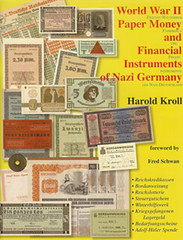 For the past six years, I have attended MPC Fest in Port Clinton, OH. On May 2, I drove onto I-495 (DC Beltway) at about 4AM and drove off of I-80/90 Port Clinton exit at 11 AM and then to the Holiday Inn Express, which is near the corner of Routes 2 and 53 and on the road to Catawaba Island.
For the past six years, I have attended MPC Fest in Port Clinton, OH. On May 2, I drove onto I-495 (DC Beltway) at about 4AM and drove off of I-80/90 Port Clinton exit at 11 AM and then to the Holiday Inn Express, which is near the corner of Routes 2 and 53 and on the road to Catawaba Island.
The usual early birds were there and I volunteered to help get things out of storage and set up. It was not too difficult and I needed the exercise. That evening, we had dinner at the Jolly Roger Restaurant, which has tasty perch and walleye sandwiches and dinners with the great local bottled ICS Root Beer.
Thursday, I spent most of the day in my room working on my Cambodia catalog. The bourse was on Friday and several sellers had military numismatic and related references. I did not buy any books but I did find three pieces of Southeast Asian paper money.
Saturday is the most active day and one of two new catalogs were announced. The first was WWII Paper Money and Financial Instruments of Nazi Germany by Harold Kroll. Over 700 full color images fill the 64 informative pages of this new reference catalog listing paper monies and financial documents issued throughout the Nazi war time period, 1932-1945. The retail price is $25. plus $3.postage. International postage is plus $10. Contact Harold at harbons@aol.com for quantity pricing.
Sunday was auction and lottery day and I won a donated copy of the new catalog! I stayed around for about half of the auction but there were really no lots in it for me. Many donations and auction profits sponsor up to four people to the ANA Summer Seminars. It is a great way to get some collectors additional numismatic knowledge and to support the ANA.
If you want to attend MPC Fest XIV, contact Fred Schwan at FredSchwan@Yahoo.com; and it you want to receive the emailed MPC Gram, contact Roger Urce at stjasele@optonline.net.
BOOK REVIEW: A CONCISE CATALOG OF U.S. MILITARY PAYMENT CERTIFICATES
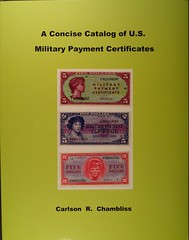 I just received my copy of A Concise Catalog of U.S. Military Payment Certificates by Carlson Chambliss.
I just received my copy of A Concise Catalog of U.S. Military Payment Certificates by Carlson Chambliss.
I like the book, partly because it is the first MPC reference book I know of with color illustrations. The title page says SPECKLES PRESS - which I wondered about. Carlson explains in his introduction: "This is a self-published book. Who then was the Speckles of the Speckles Press? He was my pet king snake whom I had for 20 years from 1973-93." Did I mention that Carlson, a retired astronomy professor, is somewhat of an eccentric? That's a trait that I admire in a person, and with which I can personally identify.
This book in no way is, nor attempts to be, a replacement for The Comprehensive Catalog of Military Payment Certificates by Fred Schwan. By calling this latest MPC book a Concise Catalog, rather than a Comprehensive Catalog, Carlson is saying that he is sticking to the subject of MPC only. However, he violates that premise to the extent that he also includes military POGS near the end of this 150 page, soft covered book. The Schwan book, last published in 2002, remains the standard reference on the subject.
All-in-all this book is a well-researched and well written reference on the subject of MPC. I recommend it. Don't you agree with me that all reference books on paper money should have color illustrations? And, you can never have too many books!
Warner writes:
Any MPC GRAMster worth his/her FEST T-Shirt can tell you what a POG is. This is the name for a children's game played with the caps of a fruit drink bottle (passion-orange-guava) originally in Hawaii in the 1920s or 1930s. The term was resurrected to describe the change used by U.S. (and some coalition) troops in Iraq and Afghanistan. The U.S. government decided to stick with Federal Reserve Notes (not MPC) in these areas, but coins are too heavy and complicated to transport to the Theaters. POGs were created by the military to have small change. Note they are not money, they are "gift certificates". Only the feds can create official currency. POGs are accepted in any U.S military exchange in the world. For collectors, see the British versions created by EFI (Expeditionary Forces Institute) to be used in NAAFI facilities.

David Klinger adds:
Here is a numismatic footnote on Carlson Chambliss.
The Chambliss Amateur Achievement Award is awarded by the American Astronomical Society for an achievement in astronomical research made by an amateur astronomer resident in North America. The prize is named after Carlson R. Chambliss of Kutztown University, who donated the funds to support the prize. The award consists of a large 224-gram (½-lb) silver medal and $1,000 cash. It has been awarded annually since 2006.
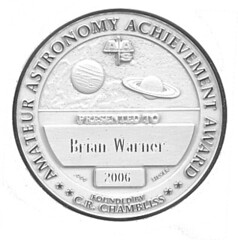
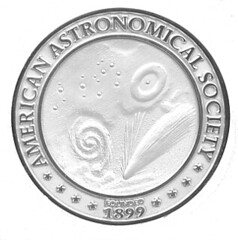
To read the earlier E-Sylum article, see: NEW BOOK: A CONCISE CATALOG OF U. S. MILITARY PAYMENT CERTIFICATES (www.coinbooks.org/esylum_v15n21a06.html)
BOOK REVIEW: TEN DAYS TO MADNESS
'There's gold in them thar' hills!'
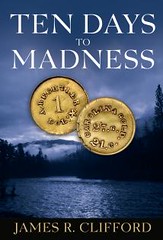 I just finished the new book by James Clifford, 'Ten Days to Madness' and enjoyed it immensely. Set in North Carolina, the book chronicles two weeks in the life of Charlie Parker, a seemingly regular guy with a regular job, regular wife, and two regular kids.
I just finished the new book by James Clifford, 'Ten Days to Madness' and enjoyed it immensely. Set in North Carolina, the book chronicles two weeks in the life of Charlie Parker, a seemingly regular guy with a regular job, regular wife, and two regular kids.
However, as the chapters unfold, we find out that 'regular' is only the top layer of Charlie's persona. On a solo getaway to the mountains we learn of his checkered past, his precarious present, and what turns into a wild and adventurous future.
Along the way we are carried back through pre-Civil War North Carolina history, including Native American lore, and Bechtler gold. Day by day, Charlie's little vacation in a throwback mountain town becomes more intense as he tries to sort out his ancestral past and map out his future. Dotted with unexpected twists and turns and in no particular order the reader is met with wild beasts, beautiful women, an evil undertaker, Cherokee chiefs, an English barkeep, and a hermit/historian numismatist - whose shack is strewn with numismatic literature! (Likely a member of the NBS)
It's fast-paced, page-turning Madness!
There are 306 pages and 23 chapters, book-ended by prologue and epilogue, and finishing with a brief history of the Bechtler mint. A bargain in either hard copy (my choice) or e-book.
Upon finishing the book I wished there was more - but that's what good novelists do - make you anticipate the next book, and I'm already looking forward to Clifford's next 'numi-novel.'
To read the earlier E-Sylum article, see: NEW BOOK: TEN DAYS TO MADNESS (www.coinbooks.org/esylum_v15n18a07.html)
REGIONAL PUBLICATIONS OFTEN REVEAL TREASURES
I received The Clarion this week. That's the organ of PAN, the Pennsylvania Association of Numismatists. Great issue and a tribute to indefatigable editor Richard C. Jewell.
As every publication is somewhat of a literary expression of its editor's likes and persona, this May 2012 issue is no exception. While there are three articles -- on Morgan dollars, two-cent pieces and the In God We Trust motto -- for coin enthusiasts, the remainder of the articles are on medals. Dick Jewel's fondness for medallic art shines through.
The full color cover is matched with an article -- by U.S. Mint designer Joel Iskowiz -- on his art work, many of which are tied to the coins, medals and stamps of national commemorative interests he has created for the U.S. Mint, foreign governments and private organizations. His paintings are highly detailed, based on intensive research, similar to his preparation for his numismatic creations.
Iskowitz likes to create what he calls "Art that tells a story." His article by the same name tells the story of how he creates that art.
I also liked the full page treatment of five medals from the John Eshbach Collection of Olympic medals, recently offered at auction by dealer Ingrid O'Neil. Each of the five featured Olympic Participation Medals are illustrated with a poster from that medal's Olympiad. Brings to mind the suggestion for numismatists to collect the association items related to the specimens in their collection. Adds graphic interest and breadth to any numismatic topic.
Two other articles are on medals. One on a 1927 Wheeling Steel Corporation Medal by Harry Waterson, and an article on James Gill who took it upon himself to sponsor a medal for the centennial medal of his California hometown. He tied the California town to Pennsylvania through an ancestor who came from Pennsylvania.
The Clarion is one of a few regional numismatic publications in large format (and in color). We must commend the parent organization, PAN, for its supporting such a viable periodical. The Sentinel comes to mind as a similar regional numismatic organ, this issued by the Central States Numismatic Society. Both of these originations are well managed and well financed to be able to sponsor their fine publications.
There is always a treasure of an article or illustration in a regional numismatic publication.
Now for the commercial. If you are not a member of PAN, consider joining. You'll receive The Clarion. Membership is only $10 a year. That's one of the best bargains in all numismatics! There are just as many members who live outside Pennsylvania as within (as evidenced by new members, page 13 this issue).
Send ten bucks to Charles Culleiton, PAN Membership Chairman, 2830 Hastings Drive, Lower Burrell, PA 15068. Make checks to PAN. Tell him Dick Johnson recommended you.
THE BOOK BAZARRE
VINCENT W. ALONES, 1916 - 2012
Vincent W. Alones, 95, a World War II Navy veteran from Long Island, NY has passed away. Vincent had his name published in the July 2011 issue of The Numismatist for being a 50 year member of the ANA. Vincent is an award-winning exhibitor who won an ANA Presidential Award in 1994 and the Medal of Merit in 1995. Vincent attended every ANA Convention from 1952 to 2008!
Vincent won over 200 prizes in numismatic competitions during his lifetime and was a long-time member of the Long Island Coin Club. His estate has provided a portion of Vincent's amazing coin collection to be sold, in part, to benefit the Virginia Numismatic Association. Vincent started collecting in 1934 and his collection contains many coins from major auctions such as the Anderson-Dupont Collection (1954), B. Frank Collection (1956), Farish Baldenhofer Collection (1955), B. Max Mehl (1942), and coins obtained from Abe Kosoff, Walter Breen, Empire, T. Weiss, and New Netherlands Coin Company. Many of the coins are gem uncirculated.
The Virginia Numismatic Association will hold its 54th annual convention, coin and currency show, September 28-30 (Friday 10 AM to 6 PM, Saturday, 10 AM to 6 PM and Sunday, 10 AM to 4 PM at the Fredericksburg Expo & Conference Center, 2371 Carl D. Silver Pkwy, Fredericksburg, VA. Session I of the Vincent Alones Estate will be sold at auction on Saturday night at 7:00 PM, September 29th, 2012, at the VNA show. Session I will include between 250 and 300 auction lots. Session I contains mostly copper coins and is especially strong in large cents, with many uncirculated and some fantastic proof examples. In addition, a nearly equal number of lots will be sold throughout the convention at fixed prices on the bourse floor.
For sale or auction will be offered over 600 U.S. large cents and about 45 colonials and half cents. Every date of large cent will be sold. Early date cent highlights include several 1793 Chain/Wreath cents, eleven 1794 large cents, multiple quantities of the remaining early dates except for a single 1799, six 1804s (genuine, restrike, and counterfeit) and an 1815 fantasy.
The real strength of the collection is with the middle date large cents with multiples of each date from 1816 on, none lower in grade than Extra Fine and with runs of "gem uncirculated" and proof examples not seen on the market for many decades. Probably some "finest known" examples such as an 1823 Restrike, Broken Die enthusiastically labeled "Proof-70" that was purchased in 1940 give a sense of the hidden beauties that may turn up during cataloging. The coins conveniently come with attribution, original auction flips, date and price paid, with some purchased as far back as 1937.
A complete list with photos, attribution and provenance is being assembled and should appear on the VNA website and/or in hardcopy catalog format by the end of July. The colonials include 1776 Continental Dollars in a variety of compositions, and other worthy lots of State coppers, Fugio cents, and French colonials. Subsequent sessions are to be determined. Special auction lots may be available for advance viewing at the Baltimore Show, the last week of June. Ask any VNA member for more information about viewing lots at the Baltimore Show. VNA members may expect a special mailing with the details.
To read Vincent Alones' obituary, see:
Vincent William Alones
(www.legacy.com/obituaries/newsday/obituary.aspx?
n=vincent-william-alones&pid=155806600)
QUERY: COUNTERFEIT PRINCE EDWARD ISLAND HOLEY DOLLARS
Chris_Faulkner ( chris_faulkner@carleton.ca ) writes:
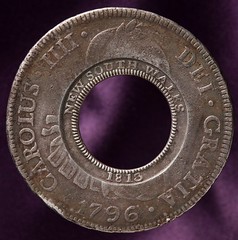 There are persistent rumours that the Prince Edward Island Holey Dollar was faked in the mid to late 1950s and early 1960s, apparently in New York, by a party or parties unknown. Can anyone throw some light on this rumour?
There are persistent rumours that the Prince Edward Island Holey Dollar was faked in the mid to late 1950s and early 1960s, apparently in New York, by a party or parties unknown. Can anyone throw some light on this rumour?
Twentieth century fakes of these coins certainly exist, and I have documented a number of them for my forthcoming book on the PEI Holey Dollar from Spink. However, when or where they might have been done is unclear (and it is too late to include such information in my book). Because PEI Holey Dollars produced in the 1813-14 period were made by fairly simple technological means and more or less by hand, on the face of it they would seem to be easy enough to fake. Matters are not quite that straightforward, however, inasmuch as the rough technology involved resulted in diagnostics which are quite difficult to duplicate.
The twentieth century fakes are not to be confused with a replica PEI Dollar and a Dump which appeared about 1961. These replica Dollars were not intended as fakes and the host coins are all dated 1793. One other point. The fakes from the 1950s and 60s appeared at the same time as a spike in fakes in the West Indies cut and countermarked series. Consequently, one might wonder whether all of these fakes came out of the same workshop or workshops. Any help with this mystery would be most appreciated and any confidences will be respected.
QUERY: JOHNS ADAMS' GOLD 1826 ERIE CANAL COMPLETION MEDAL
Rich Jewell writes:
In last week's E-Sylum Harvey Stack talks about the John Adams auction his firm conducted back in the seventies. Did Harvey or any of their catalogers happen to see the Gold 1826 Erie Canal Completion Medal that was given to John Adams and his son John Quincy Adams by the Common Council of the City of New York in honor of their celebration? That would account for two more of the gold medals!
Does anyone at the Museum of Fine Arts or Massachusetts Historical Society remember seeing them in the Adams family archives or collection of medals and coins once in their possession??
MORE ON THE 1870-S THREE DOLLAR GOLD PIECE

Joe Boling writes:
The two 1870-S $3 gold pieces aren't even close to being from the same dies. And I know we can't expect the lay press to know the difference between striking and casting, but....
To read the earlier E-Sylum article, see: ARTICLE CLAIMS 1870-S THREE DOLLAR GOLD PIECE FOUND IN A BOOK (www.coinbooks.org/esylum_v15n21a18.html)
KOLBE & FANNING NUMISMATIC BOOKSELLERS
ANSWER: WHAT DOES N.I.T. ON BRYAN MONEY STAND FOR?
Last week Michael Sanders of Beaverton, OR wrote:
OK, I should definitely know this. Can someone tell me what the initials "NIT" found on numerous pieces of Bryan Money refer to? A search of Schornstein's book did not yield an answer as far as I can find. Thanks in advance.
Bill Hyder writes:
Always wondered that myself. It's "Not In Trust". One would think that would be a basic explanation for any text on Bryan money.
Bryan money is ...
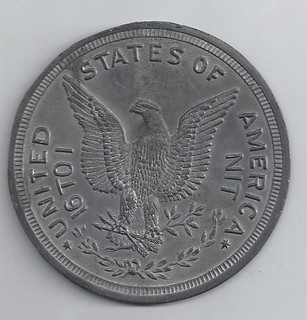 ... a token or medal struck during the campaign of 1896 to elect William Jennings Bryan, the Democratic Party nominee, President of the United States. Bryan money is considered to be pro-McKinley in the 1896 presidential election. The original tokens are scarce to rare, and there are a number of different sizes and types.
... a token or medal struck during the campaign of 1896 to elect William Jennings Bryan, the Democratic Party nominee, President of the United States. Bryan money is considered to be pro-McKinley in the 1896 presidential election. The original tokens are scarce to rare, and there are a number of different sizes and types.
With respect to Satirical Bryan Money, Farran Zerbe states: "The Satirical class comprises those pieces of numerous variety in size material with derisive or humorous inscription or design. Most all are casts; a few were struck. Type metal, or some composition of lead and aluminum were the most commonly generally used materials, with iron, copper, tin and cardboard contributing a few varieties". Thousands of such oversized coins were issued to ridicule the so-called Free Silver doctrine. Democrat candidate William Jennings Bryan and his supporters advocated the free coinage of silver and a new, bi-metal monetary standard in which silver was valued at a ratio of 16:1 to gold.
Bryan's Republican opponent, William McKinley, was endorsed by those who favored a single-metal, gold standard. They pointed out that if the Free Silver proposal were literally implemented, a coin containing a dollar's worth of silver would be "as big as a stove lid!" Hence, the size of this satirical piece, and 16 to 1 on the reverse. The letters NIT stand for "Not in Trust."
To read the complete article, see: Coin and Paper Money Collecting/Bryan Dollar (en.allexperts.com/q/Coin-Collecting-2297/2009/11/Bryan-Dollar-1.htm)
Pete Smith writes:
I pulled my copy of Bryan Money off the shelf. This is a reprint of articles by Farran Zerbe in The Numismatist beginning in the issue of July, 1926. I was sure Zerbe would tell me what NIT stood for. I was unable to find this.
A search on the web turned up "Not in Trust." I believe this but wish I found it in a print source. I understand Len Augsburger is keeping his library because there are things he can't find on the web. I think if I had to choose between the two, I would keep my access to the web.
WHO IS THAT GENT WITH LINCOLN AND GRANT? ALEXANDER II
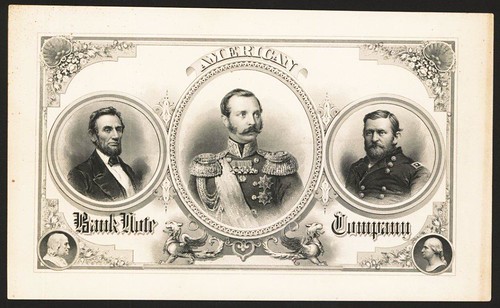
Last week Kerry Rodgers asked:
This American Bank Note Company advertising item sold for $1,652 in Archives International Auction XI held in May. It shows Lincoln and Grant flanking a gentleman. The catalog believes him to be a Russian and the item to date from the1860s. Can any reader provide an identification?
Tom DeLorey writes:
Without doing any research at all, I would guess that the distinguished gentleman with Lincoln and Grant is Prince Albert, the husband of Queen Victoria, deceased in the early 1860's.
Joe Boling agrees:
The first man who came to mind with Lincoln and Grant is Victoria's Albert.
But there were other attributions. Fabienne Burkhalter writes:
It could be Maximilian II of Mexico ?
Kerry Rodgers thought it could even be Napoleon III. All good and reasonable guesses, but wrong.
David T. Alexander writes:
The imposing monarch with Lincoln and Grant is Russian Emperor Nicholas I (ruled 1825-1855). Here was a ruler who personified "Emperor and AUTOCRAT of all the Russias..."
Pete Smith writes:
I could probably find twenty portraits of Russian Tsars or generals wearing their sash and medals that would be similar to the portrait on the American Bank Note Company advertising card. The closest match I could find was Tsar Alexander II. Something he shared with Lincoln was assassination. He was killed by a terrorist bomb on March 13, 1881.
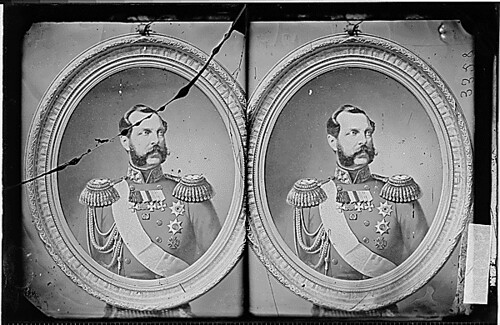
Czar Alexander II of Russia ca. 1860
The first reader to guess correctly was Greg Adams, who provided the above image from the National Archives. Ursula Kampmann, Heath MacAlpine, Robert Bauswell and Pablo Hoffman concur. Pablo writes: The person pictured in the ABNC piece in place of honor between Lincoln and Grant is Aleksandr Nikolayevich, better known to us in English as Alexander II, emperor of Russia (1855-81).
When Russia sold the Alaska territory to the United States in 1867, Czar Alexander II did not take part in the negotiations. Could it be that he did not want to take time away from meticulously manicuring his royal mustache?
Czar Alexander II was a true man of the era, sporting mutton chops along with a full mustache. He would have had no problem fitting in with the negotiators of the Alaska purchase.
Although even Moscow's top diplomats could not fill the mutton chops of a monarch, the Russian delegation made a manful attempt, with envoy Eduard de Stoeckl emulating the Czar's handlebar mustache and plush sideburns.
When the war of the whiskers finally concluded, the two sides reached an agreement. On August 1, 1868, the United States wrote de Stoeckl a check for more than 586,000 square miles in the Alaska territory for $7.2 million.
At the time, the deal was with disapproval from some, who called the enormous piece of land "Seward's Folly." But in 1896, the discovery of gold made the recently acquired district far more valuable.
To read the complete article, see: Facial Hair Friday: From Russia With Love (blogs.archives.gov/prologue/?p=6293)
Bob Julian writes:
The portrait shown between those of Lincoln and Grant appears to be that of the Emperor Alexander II (1855-1881) of Russia. The American Bank Note Company had close business dealings with the Russian Treasury in the early to mid 1860s. One of the treasures of the Hermitage numismatic library, which I had the privilege of examining in person, was the specially bound collection of engraved vignettes presented by the ABNC to Alexander II.
The ABNC arrangement with the Russian government is well covered in the article "America and Russia, the Credit Notes of 1866," which appeared in the Journal of the Russian Numismatic Society, No. 72, summer 2001.
Dennis Tucker of Whitman Publishing writes:
When I saw the ABNCo card in last week's E-Sylum, I immediately recognized it from Fred Reed's Abraham Lincoln: The Image of His Greatness (page 147). Reed identifies the mustachioed gentleman as Alexander II, Russian emperor from 1855 to 1881.
Alexander was targeted several times over the years by various revolutionaries, and finally in March 1881, in St. Petersburg, he was horrifically and fatally wounded by an assassin's bomb. (A first bomb stopped his bullet-proof carriage, then during the confusion a second bomb was thrown at his feet.) The emperor's son and grandson (both future emperors themselves) saw the assassination first-hand, and it hardened them. The fallout of the murder was hardcore repression and police brutality, pogroms, and suppression of civil liberties.
Reed identifies the Lincoln die as ABNCo Lincoln-portrait die number 141 --- Charles Burt's vision of the president, originally created in 1861 for U.S. Demand Notes.
Here at Whitman we're working on a monumental follow-up to Reed's The Image of His Greatness, which was very popular and managed to cross the "cultural divide" between mainstream American history books and numismatic books. It will be even bigger than the first volume. Watch for it later this year.
Fred Reed writes:
Years ago I asked Gene Hessler who this was since the Lincoln portrait on it is from the original ABNCo steel die and steel roller die that I own, and he identified the gentleman in the center as Alexander II of Russia. You'll find it on page 147 of my first Lincoln book, Abraham Lincoln, The Image of His Greatness, nearly full sized.
P.S. By the way, I was the purchaser of this item in the recent Archives International Auctions sale, and I'm happy to have it finally since I've been chasing it for years.
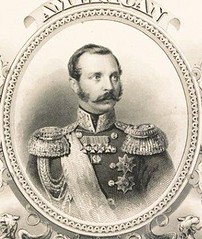
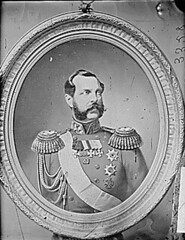
NOTES FROM E-SYLUM READERS: MAY 27, 2012
Headline Clarification: Terms vs Rules
Dick Johnson took issue with the headline I gave his submission last week. He writes:
The headline -- ANNOYING AUCTION HOUSE SALE TERMS -- implies terms (as words) and not as rules. It was the stringent rules I wrote about, not the terms.
Terms meant "Terms of Sale" in this case. I hadn't thought of terms in the context of words themselves. Now that Dick points it out, "Rules" would be a better choice, since it doesn't have the possible double meaning. Sorry!
To read the earlier E-Sylum article, see: ANNOYING AUCTION HOUSE SALE TERMS (//www.coinbooks.org/esylum_v15n21a19.html)
Apple's Jonathan Ive Gets Knight Commander Medal
Apple's design guru Jonathan Ive was knighted on Wednesday at Buckingham Palace by Princess Anne.
Ive has been working at Apple since 1992. He's been head of design since 1997, and was honored with a Commander of the British Empire (CBE) ranking in 2005. Ive credited his interest in design to his father, who was a craftsman. He also gave a nod to his home country's history in design and industry. "I'm very aware of an incredible tradition in the UK of designing and making, and so to be recognised in this way is really wonderful," Ive said.
To read the complete article, see: Jony Ive Knighted, Wants to Be Known for What He's 'Working on Now' (www.wired.com/gadgetlab/2012/05/jonathan-ive-knighted/)
Spy Nickel Hides Poison Needles
Arthur Shippee forwarded this New York Times review of a spy exhibit which includes a nickel containing poison needles. Neat!
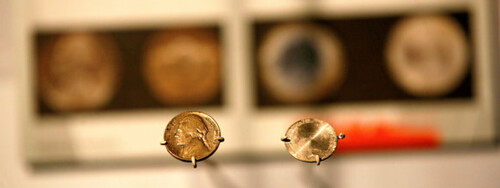
In 1953, after the early successes of Soviet espionage demonstrated just how difficult and dangerous the cold war would become, the Central Intelligence Agency began a top-secret program called MKUltra. It included exotic projects that decades later provided much critical fodder for commentators and comedians: exploding cigars, poison-laced toothpaste, hallucinogenic serums. And as we learn in a video interview with professional spies at the exhibition "Spy: The Secret World of Espionage," opening on Friday at Discovery Times Square, it even included the hiring of a magician, John Mulholland, as a C.I.A. consultant.
And why not? Spend some time here and you can feel as if you'd been admitted to the backstage preparations for a magic show. The difference is that in espionage, life or death and the fate of nations are at stake, rather than whether a woman can be successfully sawed in half or an ace of spades pulled from a shuffled deck. These magicians weren't performing; they were dueling.
Here, drawn from the immense private collection of the intelligence historian H. Keith Melton, and the collections of the C.I.A., the Federal Bureau of Investigation and the National Reconnaissance Office, are objects ranging from a poisoned needle, hidden inside a coin, to a fragment of the United States Embassy in Moscow that the Soviets riddled with bugs during its construction in the 1980s; two floors were razed and rebuilt.
To read the complete article, see:
Where Shoes Listen and Coins Kill
(www.nytimes.com/2012/05/18/arts/design/spy-secret-world
-of-espionage-at-discovery-times-square.html)
ANA APPOINTS AUTHOR JEFF SHEVLIN NEW EXECUTIVE DIRECTOR
Pete Smith writes:
Yesterday (May 26) I received promotional literature from Stack's Bowers for their ANA Rarities Night Auction. Inside were testimonials from various consignors.
On the top of page 10, was a photo identified as "Tom Hallenbeck, ANA Executive Director." Somehow, I had missed the announcement of that appointment.
Occasionally The E-Sylum scoops the other numismatic publications. Did Hallenbeck orchestrate the termination of the former executive director so he could take the position? As ANA President, did he assure his placement among candidates for the position? Did he influence the ANA Board to approve him for the position?
Inquiring E-Sylum readers will want to know. I suggest you get your squad of investigative reports working on this immediately.
Jeff Shevlin has been appointed executive director of the American Numismatic Association, the Board of Governors announced today. Shevlin brings a wealth of valuable management and leadership experience with him when he joins the ANA on June 18.
"I am exceedingly energized about the opportunity to manage the day-to-day operations of the ANA staff and to work with the Board of Governors to fulfill our shared vision of what the ANA can be," Shevlin said. "I plan to start working in Colorado Springs the week before the Summer Seminar so I have a chance to meet with the ANA staff and get ready to greet the ANA members who will be attending."
Shevlin is retiring from his current position as a chief executive manager with 34 years of public sector experience, 28 years in not-for-profit management and 15 years as an adjunct college instructor. His background is in information technology, and he has experience managing large organizations and major projects.
"With our selection, we wanted to show the membership that we are making a move forward for the ANA," said ANA President Thomas Hallenbeck. "Jeff's combination of management experience, understanding of technology and overall passion for the hobby made him the stand-out candidate. He understands the Association and its needs and will take the association in exciting new directions."
Shevlin strongly believes the ANA represents the future of the coin-collecting hobby and industry. "The challenge is getting the next generation of collectors engaged who will enjoy our hobby tomorrow," he said.
An ANA life member, Shevlin is known in the numismatic community as a writer, researcher, publisher, cataloger, public speaker, instructor and numismatic consultant to major auction firms on "So-Called Dollars," commemorative, silver-dollar-sized medals.
Shevlin has written numerous articles, given more than 50 presentations and developed dozens of award-winning competitive exhibits. He spends much of his free time with his family and enjoys the company of his wife, three children and four grandchildren. He is an avid numismatist, and loves to research and write about historical U.S. medals and the stories related to the great expositions that helped develop our country in the 1800s and early 1900s.
Shevlin will oversee 34 employees; a nearly $6 million budget; and major projects that include re-launching of the new www.money.org site in the next year and installing a Kids Zone at the Edward C. Rochette Money Museum. Shevlin encourages members to contact him with suggestions or comments at shevlin@money.org.
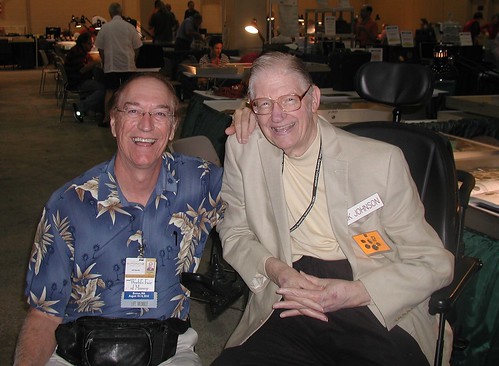
THE BOOK BAZARRE
QUERY: PUZZLE BOOK PUZZLE - PROBE OR PRESERVE?
 I enjoyed the most recent E-Sylum, as always.
I have a quandry on my hands, and perhaps readers can provide some guidance. In my collecting of coin albums, I'm frequently drawn to peripheral items that are similar in format but have a different function. At least, their purpose is not numismatic. Such an item is the one seen in the attached photos.
I enjoyed the most recent E-Sylum, as always.
I have a quandry on my hands, and perhaps readers can provide some guidance. In my collecting of coin albums, I'm frequently drawn to peripheral items that are similar in format but have a different function. At least, their purpose is not numismatic. Such an item is the one seen in the attached photos.
I purchased this children's money saving puzzle book on eBay as the sole bidder. It is copyright dated 1941, and I paid just $20. I bought it for the book alone, which appeared to be in much nicer condition than the ones I've encountered before. In so doing, I completely overlooked the possibility that there were actually coins hidden beneath the puzzle pieces, though this was the book's original purpose. The seller made no mention of coins being included, and other bidders seemingly overlooked this prospect, too, as it certainly would have sold for more to someone seeking a treasure trove.
When I received the book I was immediately struck by how heavy it was for mere cardboard. As I removed it from the shipping mailer, I heard a rattling sound. Only then did it strike me that the book did indeed contain coins. Assuming that each puzzle piece covers the appropriate denomination of coin, the book contains 20 cents, 12 nickels, 13 dimes and one quarter dollar. I'm itching to know what coins lie underneath the paper squares, but it's likely that the only way to retrieve them is by tearing the squares from the cardboard pages, ruining the collector appeal of this attractive, vintage book.
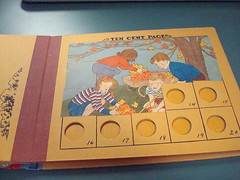
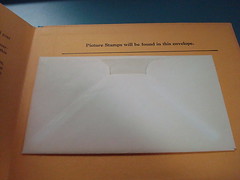
The whole scenario sounds like just another come-on of the type so often devised by deceitful eBay sellers, but I'm still wrestling with the question of what to do. One clue was offered when a loose square dropped a nickel onto my desk. Instead of a coin that would have been circulating in the early 1940s, it turned out to be a 1957-D in AU condition. This suggests that its slot, the last one filled on the nickel page, was not plugged until the late 1950s. But it still leaves the prospect that the dimes and the quarter are silver, and all of the coins probably were circulating no later than 50+ years ago.
This is like finding out that a valuable portrait was painted using a sheet of $1000 notes as the canvas. What should I do?
QUERY: TO CRACK OR NOT TO CRACK?
Michael Sanders has a related question. He writes:
I recently bought a wonderful AU-53 Hard Times Token (Rulau HT 9). It is slabbed by "First Token Grading Service." I vaguely remember this enterprise but I can find no reference to their current existence with a Google search. My question applies not only to this transitory grading service but to all of the "here today, gone tomorrow" services.
As a collector or dealer would you "crack it out" and grade it as you see it or would you leave it in the current holder? In this case I feel the grade is accurate. However, I've seen enough AU Morgan Dollars in an off brand holder graded MS-65 to realize that the holder actually diminishes the value of the coin / medal / token contained within if the buyer perceives the grading service as inferior.
My question is: TO CRACK OR NOT TO CRACK?
QUIZ ANSWER: WHICH FARMER'S BANK OF VIRGINIA NOTE IS COUNTERFEIT?

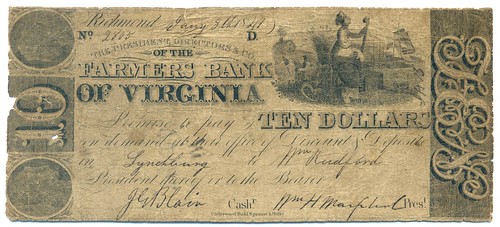
Bob Neale writes:
I'd say the lower one is the counterfeit note due to poor engraving, especially in the vignette, and the apparently reproduced signatures. But I don't know whether the bank even issued $10 notes in 1841 of same design as 1858 (or vice versa), nor do I know which are the correct signatures and how they look for real. Eric's note looks overall very much like a phony Bank of Cape Fear $10 note in my collection.
Paul Horner writes:
I think the top note is genuine. It looks to have better engraving on the vignettes. The signatures look good, matching genuine notes pictured elsewhere.
The bottom one is counterfeit. The engraving is poor, especially on the left end. The signatures look bad.
I think Eric used the Thompsons entry that mentions 10s payable at Lynchburg.
Joe Boling writes:
On the two notes of the Farmer's Bank of Virginia, the beat-up one is the counterfeit. It has considerable loss of detail in the vignettes, plus it is in position D on the sheet. President McFarland's signature has a descender that should have appeared at the top of that note, from when note C was signed. It is absent. It also lacks the second serial number applied by the bank at the upper right of the genuine note - a number that lacks a designated location, so the counterfeiter, not having a space there calling for a number, failed to enter one. I'm sure I could find more if I were not working from photographs.
Now I've scrolled down to the counterfeit detector. The 1841 $10, plate position D, made out to Radford, is cited as bad - which is the one I already identified from internal evidence. Note that neither note is signed by the cashier called for by the detector.

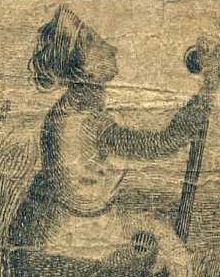
To read the earlier E-Sylum article, see: WAYNE'S NUMISMATIC DIARY: MAY 20, 2012 (www.coinbooks.org/esylum_v15n21a26.html)
KARL GOETZ BLACK SHAME MEDAL
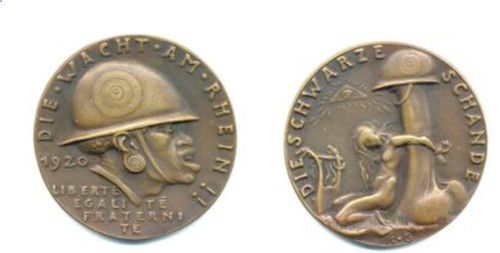
GERMANY. BLACK SHAME MEDAL, 1920. Kienast 262. 56.8mm. Cast Bronze. Karl Goetz, Sc. Edge marked: 'K. GOETZ" Choice About Uncirculated. Obverse bust right of an African soldier with exaggerated features wearing a French helmet facing right. The legend above translates as "The Watch on the Rhine." Dated 1920 to the back of the neck. Below: LIBERTE/ EGALITE/ FRATERNE/TE. On the reverse, a slumped naked figure of Lorelei is tied to a tree in the form of an erect penis capped by a French helmet. The German legend, DIE SCHWARZE SCHANDE translates as "The Black Shame."
On this medal, Goetz protests against the use of black colonial French troops in order to occupy the Rhine territory, and their alleged sexual excesses. Next to the Lusitania medal, it is undoubtedly the most famous of all of Karl Goetz's medals. $650.00
Joe's email address is JLEVINE968@aol.com -Editor
Joe writes:
Below is a link to our 82nd Exonumia Sale to be held on Saturday, June 30 in conjunction with Whitman's Coin & Currency Convention at the Baltimore Convention Center. This link will take you directly to a copy of our sale which you can read and download to your desktop. Thanks.
Joe Levine
Presidential Coin & Antique Co., Inc.
MORE ON THE FRANKLIN PARISIAN MASONIC LODGE JETON

As plenipotentiary of the United States of America he negotiated help in favour of Insurgents and was received officially at Versailles by the king. The title of plenipotentiary takes on full significance in view of the fact that at that time, the minimum delay for the exchange of a postal message between France and America, was six weeks : the man chosen to bear this title had sole responsibility in taking decisions of consequence for his country as a whole.
Benjamin Franklin succeeded then in a brilliant diplomatic mission in having the new federal republic of the United States of America recognised by monarchic Europe, including England, which made peace on 3rd September 1783, signing the Versailles treaty. France thus took her revenge on her rival, England, which had taken away Canada twenty years earlier, by the Paris treaty. Having been elected President of the state of Pennsylvania in in 1786, he died in Philadelphia on the 17th April 1790.
In a lesser-known capacity, he remains a major figurehead in the history of freemasonry. He was initiated in 1731 at the Saint John of Philadelphia lodge, to which he always remained faithful ; he became the Grand Master of Pennsylvania in 1734 and also visited the Grand Lodge of England. From 1777 to 1785 in France, he was an affiliated member of the Nine Sisters' Lodge, he was present on 7th April 1778 at Voltaire's initiation, and he was Worshipful Master from 21st May 1779 to 1781, following Lalande and preceding the Marquis de la Salle and the Comte de Milly.
The latter died in 1784 and a 'jeton' reproducing the same reverse side as that of Franklin was struck on this occasion, bearing his portrait. This lodge was founded in 1776, three years after the Grand Orient of France, following an idea of Helvetius, himself farmer general and who died in 1771. This was the most important of pre-revolutionary Masonic lodges, being the home of the most brilliant and most liberated minds, for example Voltaire and Helvetius. This did not prevent its disappearance in 1794. It started up again in 1805 and disappeared for good in 1848 never having regained its former importance.
To give the layman an idea of the importance of this lodge, of which Benjamin Franklin was the most famous Worshipful Master, a 400-page book was dedicated to it at the end of the 19th century by Louis Amiable, a most eminent freemason of the 3rd Republic. The book was republished (Paris 1989 ) with a commentary of over 200 pages by Charles Porset, a historian specialising in the 18th century at the CNRS. (National Center for Scientific Research)
To read the earlier E-Sylum article, see: NOTES FROM E-SYLUM READERS: MAY 20, 2012: On the Franklin Parisian Masonic Lodge Medal (www.coinbooks.org/esylum_v15n21a13.html)
THE GILBERT PAPER CO $1 FEDERAL RESERVE NOTES, SERIES 1963
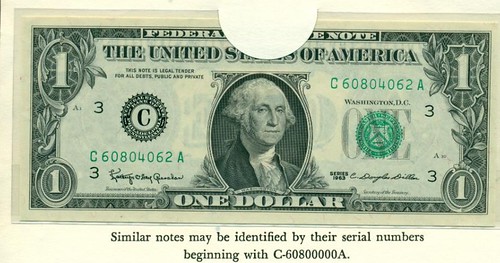
Last year Whitman Publishing put out Robert Azpiazu's book Collector's Guide to Modern Federal Reserve Notes, Series 1963-2009. On the very first page of the catalog listing (Page 1), that author writes regarding $1 Federal Reserve Notes, Series 1963: "CA [Block] C60800001A - C61440000A [Serial Numbers] Gilbert Unknown."
I believe my recent discovery of a Gilbert Paper Co. presentation folder containing the story of these notes and in addition an actual note, is historic and will help fill in some of that information. I posted images of my historic find on www.cointalk.com last November, and also want to share it with readers of Paper Money.
I also attempted to research my find. I wrote an email to the mayor of Menasha, Wisconsin asking for history of the mill, and he forwarded my email to one of the new owners of the mill and property. He, (Tom) had an interesting story how he, and his two partners bought the mill and land back in 2002.
Tom is a lawyer. He told me that after purchasing the abandoned mill, he was in the basement of the mill office building and discovered a large safe. He contacted a local locksmith and had the safe opened. There in the bottom of the safe were 1,100 new, banded $1 bills....nothing else. Neither Tom nor his two partners knew anything about the history of the mill, or the possible significance of the money.
The Crane Company has been the sole supplier of paper used in the printing of U.S. currency for more than 130 years, and back in the early 60's, the BEP sent out invitations to six different paper companies to find out if another paper company could manufacture a qualified paper, and if they could be competitive with Crane. The Gilbert Paper Company was the only company that wanted to participate, and was able to provide qualified paper to the BEP. Unfortunately, the Gilbert Paper Company was unable to supply paper at a reasonable price, so Crane remains the sole supplier of paper used to manufacture U.S. Currency.
Gilbert was contracted to provide the BEP with approximately 150,000 lbs. of distinctive paper at a total cost of $111,750. The estimated number of sheets Gilbert was to deliver was 2,167,316. They were awarded [the] only item in the total contract. There is an undated amendment notice (most likely for June of 1965) for this contract which states that the contract is considered complete with only 1,235,396 sheets having been delivered.
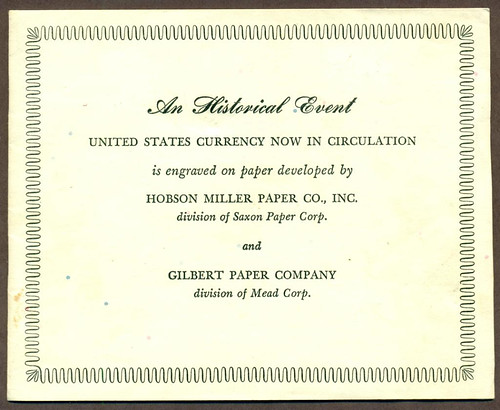
THE SCRIP OF JOHN LEONARD RIDDELL
 Dr. John Leonard Riddell was a science lecturer,
botanist, geologist, medical doctor, chemist, physicist, professor, microscopist
(the inventor of the binocular microscope), numismatist and
melter at the New Orleans Mint, an original owner of the Confederate
half dollar when it was minted in 1861, Postmaster of New Orleans under Union
and Confederate control, and once again, under Union control, issuer of his own
post office scrip and his own postage stamps, politician, a founder of the New
Orleans Academy of Sciences, and science fiction author! Above all he was involved
in various intrigues before and during the Civil War.
Dr. John Leonard Riddell was a science lecturer,
botanist, geologist, medical doctor, chemist, physicist, professor, microscopist
(the inventor of the binocular microscope), numismatist and
melter at the New Orleans Mint, an original owner of the Confederate
half dollar when it was minted in 1861, Postmaster of New Orleans under Union
and Confederate control, and once again, under Union control, issuer of his own
post office scrip and his own postage stamps, politician, a founder of the New
Orleans Academy of Sciences, and science fiction author! Above all he was involved
in various intrigues before and during the Civil War.
On August 1, 1860, after numerous distinguished and yet volatile career choices, he was appointed the United States Postmaster for New Orleans by President James Buchanan. He would be postmaster during the turbulent years just before and during the Confederate period in New Orleans. He remained true to form and engaged in several controversies.
After seven Southern states seceded, including Louisiana, the Confederate government was formed in February 1861. Even though the Civil War broke out shortly afterwards, the postal relations between the two nations remained cordial, even after Fort Sumter was attacked. The two postal services agreed that United States postage could be used in the Confederate States until June 1, 1861. However, Confederate postage stamps were not ready at that time. Riddell got the bright idea to produce his own stamps! His were among the historically interesting Confederate Postmaster Provisional series. Riddell took this action on his own and with a flourish as the story is related in the local press (The Daily Picayune, June 6, 1861).
 Further, Riddell produced his own postal scrip while
postmaster! They are curious indeed and consist of 16 distinct
denominations from ½ cent to $5 (also 500 cents). They carry
the imperative "Receivable for postage and redeemable at the
New Orleans Post Office."
Further, Riddell produced his own postal scrip while
postmaster! They are curious indeed and consist of 16 distinct
denominations from ½ cent to $5 (also 500 cents). They carry
the imperative "Receivable for postage and redeemable at the
New Orleans Post Office."
Each of these rare notes that was issued is signed or impressed with J. L. Riddell as postmaster and cosigned by a postal clerk.
New Orleans was a key commercial center of the Confederate States and was made an early goal of the Union army and navy. On April 29, 1862, Admiral Farragut sent an expedition to take control of the Customs House in New Orleans. Lo and behold Dr. Riddell was present to greet the two officers who represented the American Navy. Dr. Riddell's comments were: "Thank god that you are here. I have been a Union Man all the time. I was appointed by Buchanan and not Jeff Davis: he only allowed me to remain."
Riddell then showed and escorted these naval officers to the roof of the building and was present when the Stars and Stripes were first flown over New Orleans under Northern re-occupation. The fact that he was born a Northerner might help explain his sentiments.
A NUMISMATIC VISIT TO THE NEW YORK HISTORICAL SOCIETY
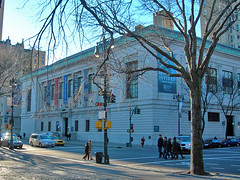 I hadn't been to the New York Historical Society on Central Park West in Manhattan since the 2003-2008 John J. Ford Stack's auctions, so I decided to renew my pleasure this past week while on vacation in NYC with my wife.
I hadn't been to the New York Historical Society on Central Park West in Manhattan since the 2003-2008 John J. Ford Stack's auctions, so I decided to renew my pleasure this past week while on vacation in NYC with my wife.
On my previous visit I discovered that the Historical Society owned two near mint state pewter specimens of the Wright pattern 1792 quarter of unknown provenance going back to the early 19th century. They quite literally didn't know what they had!
While the 4th floor numismatic exhibit - including the gold Horatio Gates Comitia Americana medal (which adorns Gates' neck in a splendid adjacent Metropolitan Museum of Art oil painting) and a huge gold 1854 entirely hand-engraved ornate NY lifesaving medal signed by Black Starr & Frost and a large gold 1889 Geo Washington Inaugural Centennial medals by St Gaudens still on exhibit - is still unchanged in these many years, unlighted in a dingy 4th floor balcony corner and barely visible, I was shocked by what else I saw.
On the street's first floor entrance lobby, open to wandering homeless drunks and anyone else who ventures in, way over in a corner on the opposite end of the main lobby from the blue jacketed unarmed "greeters" and the museum's entrance desk, in unlighted waist high dark cases are: three silver proof Seasons medals (adjacent to 3-4 valueless well-worn colonial coppers) and both of the two pewter 1792 Wright pattern quarters (next to a VF Fugio cent). You have to stoop down on bended knees to even see the medals and coins.
Now the Seasons medals' value totals easily $200K + and the two 1792 patterns over $2.5 million (based on the much more common silver center cent that just sold for $1.2M) , the Historical Society curators seem to be inattentive to both their significance and their value and most particularly the unsecure , downright hazardous conditions under which they are exhibited. Both of these waist high glass exhibit cases have a button for lights to be activated and neither lighting button even works.
What a shame.
In contrast, on the 3rd floor is an extensive well-lighted exhibit of early American silver chalices, trays, etc., all magnificently hand-engraved and unique and quite literally saliva-generating to those collectors who appreciate engraved silver scenics on their medals, as I do . Many of the silver items were literally transfixing in their beauty and historical significance. This alone was worth the visit and the $10 senior cost of entry.
For more information on the new-York Historical Society, see: www.nyhistory.org

THE REED AND HOLLAND PENNYPACKER AUCTION SALES
An Unlisted Sale of the Ira Reed Collection
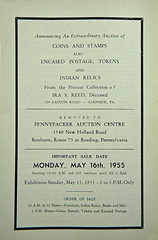 685 Pennypacker Auction Centre. ANNOUNCING AN EXTRAORDINARY AUCTION OF COINS AND STAMPS, ALSO ENCASED POSTAGE, TOKENS AND INDIAN RELICS, FROM THE PRIVATE COLLECTION OF IRA S. REED, DECEASED. Kenhorst, Reading, Pa., May 16, 1955. 8vo, self-covered. 16 pages; no lots numbers: fine collection of stamps; (48) lots of encased postage; 9 pages listing U.S. federal coins; 3 pages listing Indian artifacts, books and furniture. Fine. (150.00)
685 Pennypacker Auction Centre. ANNOUNCING AN EXTRAORDINARY AUCTION OF COINS AND STAMPS, ALSO ENCASED POSTAGE, TOKENS AND INDIAN RELICS, FROM THE PRIVATE COLLECTION OF IRA S. REED, DECEASED. Kenhorst, Reading, Pa., May 16, 1955. 8vo, self-covered. 16 pages; no lots numbers: fine collection of stamps; (48) lots of encased postage; 9 pages listing U.S. federal coins; 3 pages listing Indian artifacts, books and furniture. Fine. (150.00)
A previously unknown catalogue, unlisted in any numismatic bibliography of which we are aware. While most of the material is poorly described, the collection of encased postage is noteworthy, as is the provenance. Ira Reed was a Glenside, Pennsylvania coin dealer who issued a number of auction catalogues and other publications, including the 1941 ANA sale. He died in October of 1954. The fact that this sale apparently has been completely forgotten is really quite remarkable. Indeed, it is a month earlier than the earliest Pennypacker sale included by Gengerke.
The Holland Pennypacker Sale
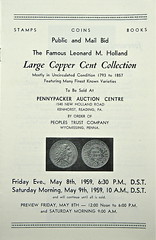 686 Pennypacker Auction Centre. STAMPS - COINS - BOOKS. PUBLIC AND MAIL BID. THE FAMOUS LEONARD M. HOLLAND LARGE COPPER CENT COLLECTION. MOSTLY IN UNCIRCULATED CONDITION 1793 TO 1857, FEATURING MANY FINEST KNOWN VARIETIES. Kenhorst, Reading, Pa.: Catalogued by Mason-Dixon Coin Exchange (Thomas Warfield), May 8-9, 1959. 8vo, self-covered. 16 pages; (103) lots of large cents; 261 lots of other coins; (11) lots of stamps; 200 lots of books; 10 halftone illustrations of large cents. Fine. (200.00)
686 Pennypacker Auction Centre. STAMPS - COINS - BOOKS. PUBLIC AND MAIL BID. THE FAMOUS LEONARD M. HOLLAND LARGE COPPER CENT COLLECTION. MOSTLY IN UNCIRCULATED CONDITION 1793 TO 1857, FEATURING MANY FINEST KNOWN VARIETIES. Kenhorst, Reading, Pa.: Catalogued by Mason-Dixon Coin Exchange (Thomas Warfield), May 8-9, 1959. 8vo, self-covered. 16 pages; (103) lots of large cents; 261 lots of other coins; (11) lots of stamps; 200 lots of books; 10 halftone illustrations of large cents. Fine. (200.00)
The Pennypacker sale was a remarkable event, offering a fine collection of large cents assembled in the late 1940s and 1950s, mostly acquired from Leonard Holland's good friend Thomas Elder. Holland pledged the collection as collateral for a construction project loan in the late 1950s. He encountered unforeseen difficulties and the bank foreclosed the loan, choosing an obscure country auctioneer to liquidate the collection. Distribution of the catalogue was limited and the coins generally sold for low prices. Some of the important collectors of the day did not learn of the sale and several of the attendees funneled their bids through a single agent.
After the sale, it is reported that the coins were again auctioned within the group in a hotel room. Sometimes, the differences were dramatic, with coins subsequently bringing double or triple the original hammer price. Notables attending the sale included Ray Gallo, Louis Helfenstein, Dorothy Paschal, Gene Reale, C. Douglas Smith, Harvey Stack, Willard C. Blaisdell, Michael Kolman, Allen McDowell and Walter Breen.
SCOTLAND ISSUES QUEEN'S DIAMOND JUBILEE £10 NOTE
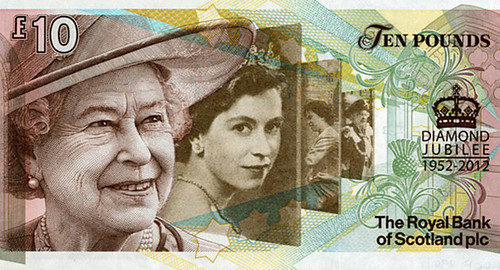
A new £10 note to mark the Queen's Diamond Jubilee has been launched by Royal Bank of Scotland.
The commemorative note features images of the Queen through the years, from the official palace photo taken of her in the 1940s to a picture of the Queen at Epsom Racecourse in 2008.
The design is the third in RBS' royal series, which also includes a £20 note for The Queen Mother's 100th birthday in 2000 and a £5 note for the Queen's Golden Jubilee in 2002. It celebrates the Queen's connections with Scotland and the bank, which was the first to include a portrait of the British monarch in 1727. The Bank of England began to feature the monarch in 1960.
The new Diamond Jubilee note is legal tender and will available from Scottish RBS branches or on order. 2 million of the commemorative notes have been put into circulation, a week before celebrations for the jubilee begin.
To read the complete article, see: Many faces of the monarch: Diamond Jubilee £10 note launched (uk.finance.yahoo.com/news/diamond-jubilee-commemorative-rbs-%C2%A310-note-unveiled.html)
FEATURED WEB SITE: SHEAFF : EPHEMERA
This week's Featured Web Site is the Sheaff : ephemera site suggested by Paul Horner, who writes:I found this website. It's not strictly numismatic, but there is a lot of great material that relates to engraving. Check it out!
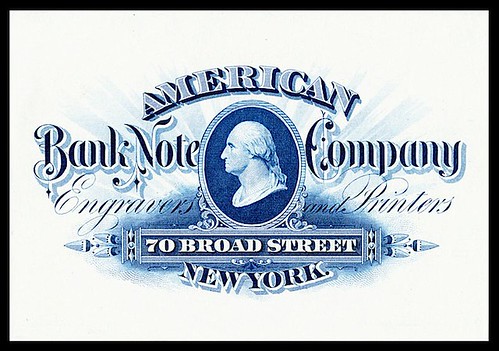
www.sheaff-ephemera.com
